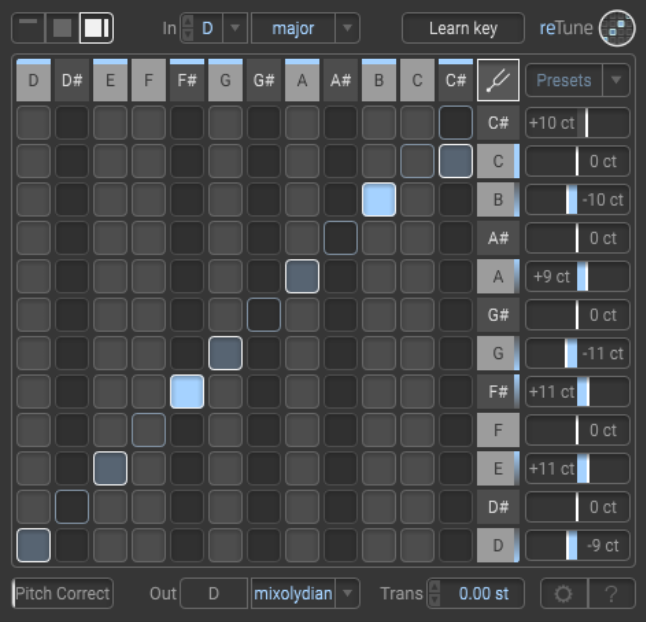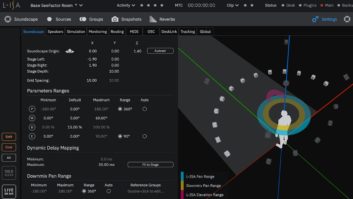If you have ever wanted to change a song’s arrangement after it’s been recorded, zplane’s reTune plug-in provides a shortcut. Instead of calling back the musicians to re-record the tune, you can use reTune to independently change each pitch in your tracks—whether monophonic or polyphonic, in melodies or chords—to any other pitch. For example, you can pitch-shift downward all C natural notes in a piano track to become B notes, while shifting upward all G notes to become A notes (effectively changing all C mj chords in the track to E sus4).
reTune can also quantize each pitch to the nearest semitone (think pitch correction) and boost or attenuate transients. And with the release of version 1.2, you can fine-tune each processed pitch ±50 cents and use MIDI notes to map input pitches (those that the plug-in receives as audio) to output (re-tuned) pitches.
I reviewed the AU version of the cross-platform reTune (also available in AAX and VST formats) in Digital Performer 9.5, using an 8-core Mac Pro running macOS 10.9.5.

Excellent Interface
Working with reTune is easy once you learn what the controls do; the operating manual could better explain some functions. Clicking on one of the three icons in the top-left corner of the plug-in’s well-designed GUI shows the control set in simple, normal or advanced view (adding or removing controls). You tell reTune the key of the input audio using two drop-down menus that select the root note and scale (scale selections include chromatic, the seven scale modes, harmonic minor, and two “gypsy” scales). Don’t know the key? Click the Learn button while playing your track and reTune will suggest a key. A Transpose box lets you transpose the audio up or down as much as 24 semitones (two octaves) and fine-tune the transposition in cents. Transposing causes a readout to display the output audio’s new root note, and a pop-up menu lets you select the output scale that transposed notes will be re-tuned to. The available selection of output scales is the same as that in the input-scale menu.
To re-tune individual notes, use the centrally located transpose matrix. Displayed in columns and rows of cells representing pitches, the matrix is visible only in normal and advanced views (see image 1, above). In the matrix, reTune’s possible input pitches (C, C#, D and so on) are laid out chromatically along the top row, and its possible output pitches are arranged similarly in the right-most column. When you select input and output scales for reTune to use, the notes belonging to those scales are highlighted in the top (input-pitch) row and right-most (output-pitch) column for easy identification. Re-tuning a note is easy: In the column below an input pitch’s name, simply click on the cell representing the pitch (shown in the right-most column) you’d like it to be re-tuned to.
When you select an input scale, all cells belonging to the scale turn blue-gray to show that they’ve been activated (in zplane parlance). Clicking on any cell also toggles activation on and off. In the bottom-left corner of the GUI, the Pitch Correct slider’s setting determines how much pitch correction (that is, quantization strength) will be applied to activated cells only; the Pitch Correct slider doesn’t affect cells that haven’t been activated or wholesale pitch-shifting executed by the Transpose box.

Four rotary controls—all continuously variable—are arranged vertically along the GUI’s right side. Lower the Sensitivity control to re-tune or pitch-shift only the loudest pitches, weeding out quiet grace notes and the like. Raising the Transients control above its “100%” setting boosts transients (creating a sharper attack), whereas lowering it below 100 percent attenuates transients (for a softer sound). According to zplane, the Smoothing control adjusts, in milliseconds, how smoothly “a [pitch] transition takes place if a note oscillates between two notes,” and is used—at high settings—to avoid the “Cher pitch-jump effect.” The Dry/Wet control adjusts the blend of processed and unprocessed audio at reTune’s output.
Related: Mini Review: zplane Élastique Pitch Plug-In, by Brandon Hickey, Mix, May 26, 2009
When you click on the tuning fork icon (situated in the top-right corner of the transpose matrix), the four rotary controls disappear and are replaced by horizontal micro-tuning sliders that finely adjust each output note’s pitch (see image 2, above). The micro-tuning sliders let you apply different temperaments (versus equally spaced semitones) to re-tuned tracks. A drop-down menu lets you select from six common tuning systems, as well as save and load your own micro-tuning settings. The micro-tuning sliders can also be used with the Dry/Wet control to apply chorus effects to select notes only.
If your DAW allows, you can use a MIDI controller to send MIDI notes to reTune. While MIDI notes are held, the transpose matrix’s current pitch mapping is overridden and audio input to reTune is instead mapped and re-tuned to the closest MIDI pitches. Playing a single note on your controller will normally result in all input audio being re-tuned to that note’s pitch; however, in reTune’s preferences, you can delimit the range in input pitches (up to ±6 semitones) that will be re-tuned to a received MIDI note’s pitch.
Something of Note
reTune offers hands down the best polyphonic pitch processing I’ve heard to date. It worked great re-tuning strummed acoustic guitar in real time to produce different chords. Re-tuning acoustic grand and sampled Rhodes piano tracks, however, often generated quiet rogue pitches lasting a split second. (The re-tuned Rhodes piano also sometimes produced unwanted portamentos, no doubt—and understandably—due to modulation in the samples confusing reTune’s pitch analysis.) Because reTune always moves notes the shortest distance possible, I, unfortunately, wasn’t able to create chord inversions in which re-tuned notes were moved a perfect fifth or more.
reTune’s pitch-correction algorithm did a good job of improving a pitchy vocal track’s intonation, but it also made the track sound subtly phase-y. Transposing the same track even one semitone up or down at times produced fleeting pitch artifacts at the start of falsetto vocal passages. The Transpose function did a much better job on a strumming nylon-string guitar track, cleanly transposing it as much as eight semitones down. Transposing the guitar track up, I started to hear significant modulation artifacts (like a very subtle wah-wah effect) with a shift of more than about seven or eight semitones—still an impressive operational range. But whether transposing up or down, reTune did not preserve or offer separate control of the instrument’s formants, limiting the practical usefulness of large-interval transpositions for most tracks.

That said, transposing stereo room mics on drums down as much as six semitones sounded great. (Any more than a six-semitone shift produced modulation artifacts on cymbals.) And adjusting the Transients control did more than change how punchy the drums sounded: at fairly extreme settings, it also raised or lowered the level of traps on the track dramatically, with exceedingly low settings producing a very ambient sound.
Related: Field Test: zplane vielklang Auto-Harmonization Plug-In, by Jim Aikin, Mix, July 1, 2007
I could also transpose a full, complex mix—a power ballad featuring drums, bass, grand piano, sampled keys, pedal steel, virtual strings, and electric and acoustic guitars—up or down two semitones without readily noticing unnatural-sounding formants in the lead vocal. Transposing the instrumental mix (sans vocals), I could transpose up four semitones or down two before formant shifting became objectionable. Boosting the Transients control sounded terrific on instrumental mixes transposed down, restoring detail.
Using the Transpose box to shift a bass guitar track down a full octave, with the Dry/Wet control set to below 50 percent, produced the best-sounding (most pitch-stable) octave effect for that instrument I’ve heard to date. I also created a terrific chorus effect on a synth-piano track using reTune’s micro-tuners and the Dry/Wet control. reTune isn’t perfect, but for polyphonic re-tuning and bass octave doubling, it’s sonically superior to the competition.
Michael Cooper is a recording, mix, mastering and post-production engineer and a contributing editor for Mix magazine.
Product Summary
Company: zplane
Product: reTune
Website: zplane.de
Price: $149
Pros: Best-of-breed polyphonic retuning; transpose function (within limits) and Transients control sound great on drums and full instrumental mixes; creates superior octave effect on bass guitar, great chorus effects; well-designed GUI.
Cons: Polyphonic re-tuning of keyboards and pitch correction or transposing of vocals can produce artifacts; arbitrary chord voicings; no control of formants; operation manual needs improvement.
Try This
If your song modulates to a different key, stop your DAW’s transport at the point at which the key change begins, adjust reTune’s pitch mapping to address the key change, and take an automation snapshot.
Related: DAWs Do It All, by Strother Bullins, Mix, Nov. 6, 2017







